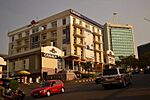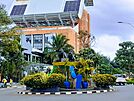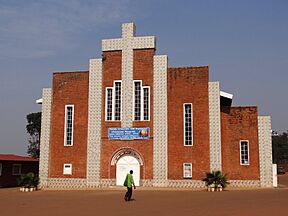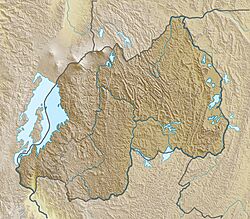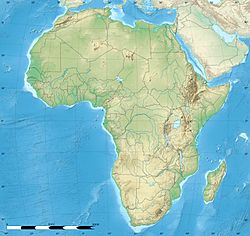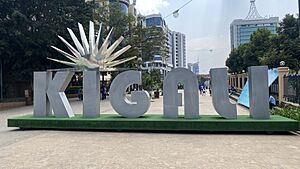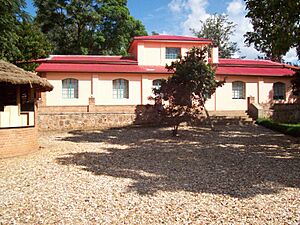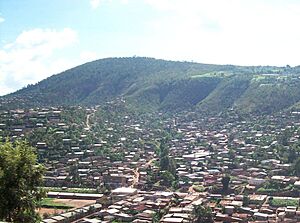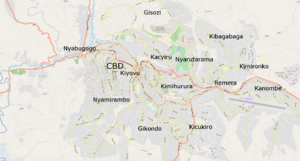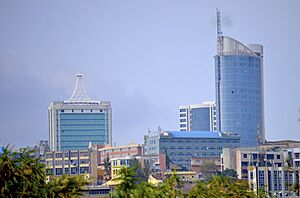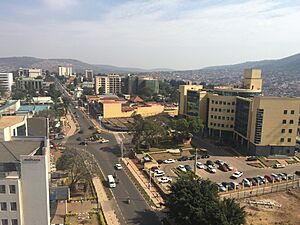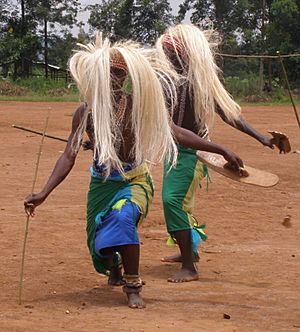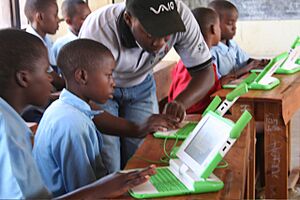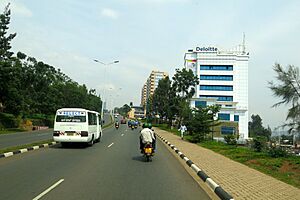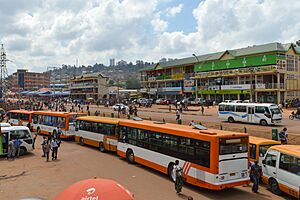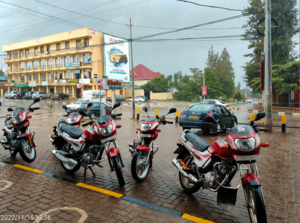Kigali facts for kids
Quick facts for kids
Kigali
|
|
|---|---|
|
Kigali Convention Center
Kigali CBD
Gorilla monument and Kigali City Council
Sainte-Famille Church
|
|
| Country | |
| Province | Kigali |
| Founded | 1907 |
| Area | |
| • Capital city | 730 km2 (280 sq mi) |
| Elevation | 1,567 m (5,141 ft) |
| Population
(2022 census)
|
|
| • Capital city | 1,745,555 |
| • Density | 2,391/km2 (6,190/sq mi) |
| • Urban | 1,518,632 (87%) |
| • Rural | 226,923 (13%) |
| • Male | 888,882 (50.92%) |
| • Female | 856,673 (49.08%) |
| Time zone | UTC+02:00 (CAT) |
| Districts
1. Gasabo 2. Kicukiro 3. Nyarugenge |
|
| HDI (2018) | 0.615 medium · 1st of 5 |
Kigali (Kinyarwanda pronunciation: [ki.ɡɑ́.ɾi]) is the capital and largest city of Rwanda. It is located near the center of the country. Kigali is known for its rolling hills, valleys, and steep slopes.
Even though it's a relatively new city, Kigali has been Rwanda's main center for business, culture, and transportation since it was founded in 1907. It became the country's capital when Rwanda gained independence in 1962.
The city was founded in 1907 by Richard Kandt, a German colonial resident. He chose the spot for its central location, good views, and safety. Foreign traders soon started doing business in Kigali. Kandt also opened schools for Rwandan students.
During World War I, Belgium took control of Rwanda. Kigali remained the main administrative center for Rwanda. However, it stayed a small city with only about 6,000 people by the time Rwanda became independent.
Kigali grew slowly over the next few decades. It was not directly affected by the Rwandan Civil War that started in 1990. However, in April 1994, Rwanda's President was killed near Kigali. This event led to the tragic Rwandan genocide, where many people were killed. The fighting resumed, and the rebel group, the Rwandan Patriotic Front (RPF), took control of Kigali on July 4, 1994. Since then, Kigali has grown very quickly, and much of the city has been rebuilt.
Today, Kigali is one of Rwanda's five provinces. It is divided into three districts: Gasabo, Kicukiro, and Nyarugenge. The city is also home to the president of Rwanda's main residence and most government offices. The biggest part of Kigali's economy comes from the service sector. However, many people also work in agriculture, including small-scale farming. Attracting international visitors for tourism, conferences, and exhibitions is very important for the city.
Contents
What's in a Name?
The name Kigali comes from the Kinyarwanda language. It combines "ki-" with "-gali," which means "wide" or "broad." This name was first used for Mount Kigali, probably because the mountain itself is wide. The city was later named after the mountain.
According to Rwandan stories, the name started in the 14th century. A scholar named Alexis Kagame studied these stories. He wrote that the name Kigali came about after King Cyilima I Rugwe conquered the area. The legend says that Rugwe looked at the land from a hill and said, "this country is vast."
Kigali's Past: A Journey Through Time
Early Days of Kigali
The first people to live in what is now Rwanda were the Twa. They were hunter-gatherers who settled here thousands of years ago. Later, between 700 BC and 1500 AD, Bantu groups, including the Hutu and Tutsi, arrived. They started clearing forests for farming.
The Kingdom of Rwanda began in the 14th century near Lake Muhazi, about 40 kilometers (25 miles) east of modern Kigali. At first, Kigali was a small part of this kingdom. It had bigger and stronger neighbors like Bugesera and Gisaka.
In the 16th century, a king from Gisaka killed Rwanda's king. But the Rwandan king's son, Cyilima I Rugwe, fought back. With help from Bugesera, he expanded Rwanda's land. Later, in the 17th century, a new Rwandan king, Ruganzu II Ndoli, led invasions. This made the Rwandan kingdom very powerful in the area. The capital of the kingdom was at Nyanza, in the south.
Colonial Times in Kigali
Kigali was officially founded in 1907. This is when German explorer Richard Kandt became the first resident of Rwanda. He chose Kigali as his headquarters. Kandt's house was the first European-style house in the city. It is now the Kandt House Museum of Natural History.
In 1908, Kandt allowed foreign traders to come to Rwanda. This started business in Kigali. The first businesses were set up by Greek and Indian merchants. They traded things like cloth and beads. Kandt also opened government schools for Tutsi students.
During World War I, Belgian forces took control of Rwanda. They captured Kigali on May 6, 1916. In 1922, the Belgians were given control of Rwanda and Burundi. They formed a territory called Ruanda-Urundi. Kigali remained the center for Rwanda's colonial government. However, the main capital for Ruanda-Urundi was in Usumbura (now Bujumbura) in Burundi. Kigali stayed quite small, with about 6,000 people, until Rwanda became independent in 1962.
Kigali After Independence
Kigali became the capital of independent Rwanda in 1962. It was chosen because of its central location. The city grew steadily. By the early 1970s, it had 25,000 people. By 1991, the population was around 250,000.
In April 1994, President Habyarimana was killed when his plane was shot down near Kigali International Airport. This event was the start of the Rwandan genocide. During this terrible time, many Tutsi people and moderate Hutu people were killed. Kigali became a place of fierce fighting between the army and the RPF. The RPF gradually took control of most of Rwanda. They captured Kigali on July 4, 1994. This day is now celebrated as Liberation Day, a national holiday.
Since the war and genocide, Kigali has grown very fast. Many damaged buildings were removed, and the city has been rebuilt. Modern office buildings and new infrastructure are now common. A plan for the city, made in 2013, aims to make Kigali a modern city by 2040.
Kigali's Location and Landscape
Kigali is in the center of Rwanda. It uses Central Africa Time, which is two hours ahead of Coordinated Universal Time (UTC+02:00). The city's borders are the same as the Kigali province. It shares borders with the Northern, Eastern, and Southern provinces.
Kigali is a city of rolling hills, valleys, and steep slopes. It is located between Mount Kigali and Mount Jali. Both mountains are over 1,800 meters (5,900 feet) above sea level. The lowest parts of the city are about 1,300 meters (4,300 feet) high. The soil on the hills is reddish, and in the valleys, it's made of river deposits.
The Nyabarongo River, which is part of the Nile's upper waters, forms the western and southern edges of Kigali. The largest river flowing through the city is the Nyabugogo River. This river flows from Lake Muhazi and then into the Nyabarongo. The rivers have wetlands next to them. These wetlands help store water and protect the city from floods. The "Umusambi Village" is a restored wetland in Kigali. It is a safe place for grey crowned cranes.
Exploring Kigali's Neighborhoods
Kigali's main business area, called the CBD, is on Nyarugenge Hill. This is where the city was first founded in 1907. Many of Rwanda's tallest buildings are in the CBD. This includes the 20-story Kigali City Tower. The headquarters of major banks and businesses are also here.
Southwest of the CBD is Nyamirambo. This area was built in the 1920s for government workers and traders. Many of these traders were Muslim, so Nyamirambo became known as the "Muslim Quarter." The Green Mosque (Masjid al-Fatah) is Kigali's oldest mosque, built in the 1930s. Nyamirambo is known for its diverse culture and lively nightlife.
North of Nyamirambo is Nyabugogo. This area is in a valley and is home to Kigali's main bus station. Buses leave from here for many places in Rwanda and other countries.
East of the CBD are other neighborhoods. Kiyovu is close by, on the eastern slopes of Nyarugenge Hill. The higher part of Kiyovu has been home to wealthy residents for a long time. The Rwandan president's home is in this area.
Other eastern neighborhoods include Kacyiru, where most government offices are. Gisozi is home to the Kigali Genocide Memorial. Nyarutarama is a wealthy area with the city's only golf course. Kimihurura, Remera, and Kanombe are also in the east. Kigali International Airport is located in Kanombe. Kigali has been called the "cleanest city in Africa" in recent years.
Kigali's Weather
Kigali has a tropical savanna climate. This means it's usually warm, but cooler than other places near the equator because of its high elevation.
The average daily temperature is between 15 and 27°C (59 and 81°F). There isn't much change in temperature throughout the year. Kigali has two rainy seasons: from February to June and from September to December. There are also two dry seasons. The main dry season is from June to September, when it often doesn't rain at all. The shorter dry season is from December to February. April is the wettest month, and July is the driest.
| Climate data for Kigali Airport (1991–2020) | |||||||||||||
|---|---|---|---|---|---|---|---|---|---|---|---|---|---|
| Month | Jan | Feb | Mar | Apr | May | Jun | Jul | Aug | Sep | Oct | Nov | Dec | Year |
| Record high °C (°F) | 33.4 (92.1) |
35.4 (95.7) |
34.0 (93.2) |
31.2 (88.2) |
31.6 (88.9) |
30.8 (87.4) |
31.1 (88.0) |
32.4 (90.3) |
32.8 (91.0) |
32.4 (90.3) |
30.6 (87.1) |
32.0 (89.6) |
35.4 (95.7) |
| Mean daily maximum °C (°F) | 27.5 (81.5) |
27.8 (82.0) |
27.1 (80.8) |
26.4 (79.5) |
26.3 (79.3) |
26.7 (80.1) |
27.4 (81.3) |
28.2 (82.8) |
28.2 (82.8) |
27.4 (81.3) |
26.3 (79.3) |
26.8 (80.2) |
27.2 (81.0) |
| Daily mean °C (°F) | 21.9 (71.4) |
22.0 (71.6) |
21.7 (71.1) |
21.5 (70.7) |
21.5 (70.7) |
21.3 (70.3) |
21.4 (70.5) |
22.3 (72.1) |
22.3 (72.1) |
21.9 (71.4) |
21.2 (70.2) |
21.5 (70.7) |
21.7 (71.1) |
| Mean daily minimum °C (°F) | 16.2 (61.2) |
16.3 (61.3) |
16.2 (61.2) |
16.5 (61.7) |
16.6 (61.9) |
16.0 (60.8) |
15.4 (59.7) |
16.4 (61.5) |
16.4 (61.5) |
16.3 (61.3) |
16.1 (61.0) |
16.2 (61.2) |
16.2 (61.2) |
| Record low °C (°F) | 12.0 (53.6) |
12.4 (54.3) |
12.9 (55.2) |
12.5 (54.5) |
13.0 (55.4) |
12.4 (54.3) |
7.7 (45.9) |
11.0 (51.8) |
11.2 (52.2) |
11.6 (52.9) |
12.8 (55.0) |
12.0 (53.6) |
7.7 (45.9) |
| Average precipitation mm (inches) | 84.2 (3.31) |
83.9 (3.30) |
129.1 (5.08) |
135.5 (5.33) |
88.7 (3.49) |
20.3 (0.80) |
10.2 (0.40) |
30.2 (1.19) |
64.8 (2.55) |
108.8 (4.28) |
121.2 (4.77) |
76.4 (3.01) |
953.5 (37.54) |
| Average precipitation days (≥ 1.0 mm) | 8.5 | 7.8 | 12.9 | 14.4 | 9.8 | 2.3 | 0.9 | 3.6 | 7.9 | 12.5 | 13.6 | 9.9 | 104.2 |
| Source: NOAA | |||||||||||||
People of Kigali
In 2012, Kigali had 1,132,686 people. Most of them lived in urban areas. When Rwanda became independent in 1962, Kigali only had 6,000 residents. It grew a lot after becoming the capital. By 1991, the population was around 235,000.
After the 1994 genocide, many people moved to Kigali. This, along with a high birth rate, made the city grow very quickly. By 2012, the population had almost doubled to 1.13 million. This was also partly because the city's boundaries were expanded.
In 2012, slightly more than half of Kigali's residents were male. The population is very young. About 73% of residents are under 30 years old. This is because many working-age people move to the city from rural areas.
Kigali has a lower poverty rate than the rest of Rwanda. In 2014, 15% of people in Kigali lived in poverty, compared to 37% nationwide. The biggest job sector in Kigali is agriculture, fishing, and forestry. Other major jobs are in utilities, finance, trade, and government.
Kigali scores high on the Human Development Index (HDI). This measure looks at health, education, and living standards. In 2018, Kigali's HDI was 0.632, the highest in Rwanda. This shows that the city has improved a lot over the years.
Like the rest of Rwanda, Christianity is the main religion in Kigali. In 2012, most people were Protestant or Catholic. Islam is also more common in Kigali than in other parts of Rwanda.
Kigali's Economy
Kigali is Rwanda's main business and financial center. It's the biggest place for trade and business in the country. Experts estimate that Kigali makes up a large part of Rwanda's total economic output.
The biggest part of Kigali's economy is the service sector. This includes things like shops, technology, transportation, hotels, and real estate. The city wants to grow its business services. It has built many modern buildings in the CBD, like the Kigali City Tower.
Attracting international visitors is very important for Kigali. This includes tourists, as well as people coming for conferences and exhibitions. Kigali is a main starting point for tourists visiting Rwanda's national parks to see mountain gorillas. The city also has its own attractions, like the Kigali Genocide Memorial. New facilities, such as the Kigali Convention Centre, have helped bring big events to Kigali. For example, the Commonwealth Heads of Government Meeting was held here in June 2022.
Agriculture, fishing, and forestry employ the most people in Kigali. Farmland covers over 60% of the city's area, mostly in the outer parts. Much of the farming is small-scale, but there are also larger, modern farms. Other major job areas include government, transportation, communication, construction, and manufacturing.
Industry is a smaller part of Kigali's economy. There is an industrial zone set up in the 1970s. In 2014, a special economic zone was created near Kigali International Airport. Companies in this zone get good infrastructure and tax breaks. This has attracted many businesses that make products like paper and foam mattresses. Kigali is also near mines for cassiterite (used for tin) and tungsten. Some of these minerals are processed locally, like at the Karuruma smelter.
How Kigali is Governed
Kigali is a city that acts like a province in Rwanda. Its current boundaries were set in 2005. The city government is in charge of planning and urban development. It also works with the three districts: Gasabo, Kicukiro, and Nyarugenge. These districts are divided into 35 smaller areas called sectors.
Since January 2020, Kigali has a new administrative system. The city council now has much more power, including control over the budget. The districts are no longer separate legal groups. Their mayors were replaced by administrators appointed by the national government.
The city council has eleven members. Six are elected by the public, and five are appointed by the president. Council members serve for five years. The mayor leads the city government's executive branch. The current mayor is Samuel Dusengiyumva. Most Rwandan government offices are also located in Kigali, especially in the Kacyiru and Kimihurura neighborhoods. This includes the president's office and the parliament buildings.
Safety in Kigali
The Rwanda National Police (RNP) provides policing in Kigali. Kigali is known for being a very safe city. Travel guides often call it one of the safest capitals in Africa.
The police work to keep crime rates low through community policing. They work with schools, businesses, and local governments. While there are some crimes like burglary and petty theft, violent crime is rare. For visitors, pickpocketing is the biggest concern. Rwanda generally has lower crime rates than other countries in East Africa.
Even though people can protest with a permit, large gatherings are rare. This is because people are often afraid of being arrested. However, protests that do happen are usually peaceful. The risk of terrorism in Kigali is considered very low.
Kigali's Culture
Music and Dance
Kigali is now a center for Rwandan culture. The country's traditional dance, which has three parts, is performed by many groups in the city. Drums are very important in traditional Rwandan music. Drummers play together in groups, usually with seven to nine people. Traditional music is performed in venues across the city.
Kigali also has a growing popular music scene. It's influenced by music from other African countries and America. Hip hop is the most popular style. Since 2011, the Kigali Up music festival has been held every year. Artists from Rwanda and other countries perform different styles of music, like reggae and blues. The Hobe Rwanda Festival in September also features music, dance, and local art.
Film Industry
Many films about the Rwandan genocide have been made in Kigali. These include 100 Days and Sometimes in April. Some films, like Hotel Rwanda, were set in Kigali but filmed elsewhere. Survivors of the genocide have even acted in some of these movies.
Kigali also has its own growing film industry, sometimes called "Hillywood." This name combines Rwanda's nickname, "land of a thousand hills," with Hollywood. The Rwanda Film Festival used to be held annually in Kigali.
In July 2023, the first Kigali Cine Junction film festival took place. It was held in public places in Nyamirambo and Biryogo. Most screenings were outdoors. The festival aims to make Kigali a major cinema capital in Africa. It brings together local and international filmmakers and celebrates Rwandan cinema. The second festival was held in August 2024.
Important Days
Genocide Memorial Day is a national holiday every year on April 7. On this day, the Kigali Genocide Memorial hosts Kwibuka. The president lights a "flame of hope" and speaks to the nation. This is followed by a week of mourning. On July 4, Rwanda celebrates Liberation Day.
The last Saturday of every month is umuganda in Kigali. This is a morning of mandatory community service from 8 AM to 11 AM. Everyone between 18 and 65 is expected to help with community tasks. This could be cleaning streets or building homes for people in need. Most normal services close during umuganda.
Food in Kigali
Kigali's food is similar to the rest of the country. Common foods include bananas, plantains (called ibitoke), beans, sweet potatoes, and cassava. These foods are often served in restaurants as part of a buffet meal called a mélange. This meal can also include meat, chips, or fish. Cassava leaves are used to make a stew called isombe.
Brochettes are very popular for eating out in the evening. They are usually made from goat, but can also be beef or fish. Kigali has restaurants that serve food from other countries, like Chinese, French, Indian, and Italian. Popular drinks include ikivuguto, which is fermented milk, and urwagwa banana beer.
Learning in Kigali
In the past, Butare was Rwanda's main center for higher education. But Kigali has become a major learning hub since the mid-1990s. Public institutions like the Kigali Health Institute (KHI) and Kigali Institute of Science and Technology (KIST) were founded here. Private universities like the Kigali Independent University (ULK) also opened.
In 2013, the government changed the public university system. Many institutions, including those in Kigali, were merged to create the University of Rwanda. It has six colleges and nine campuses, with three in Kigali. These campuses focus on business, science, architecture, engineering, medicine, and health sciences.
In 2018, Kigali had 239 primary schools with over 200,000 students. It also had 143 secondary schools with about 61,000 students. The city's districts often have the best primary school exam results in the country. Some of the top secondary schools are also in Kigali. The city also has private schools for wealthy Rwandans and foreigners. These schools offer international programs that help students study at universities worldwide.
Since the 2022–2023 school year, parents no longer pay school fees for pre-primary and primary students. They only contribute a small amount for school meals. This helps more children attend school.
Sports in Kigali
The largest sports venue in Kigali is Amahoro Stadium in Remera. It was built in the 1980s and can hold 45,000 people. The stadium is mainly used for association football. It hosts most games for the Rwanda national football team and local matches. It also hosts rugby union games and concerts.
The Amahoro complex also has an indoor venue called Petit stade. The Kigali Arena is a large indoor arena next to Amahoro Stadium. It opened in 2019 and can hold 10,000 people. It hosts sports like basketball, handball, volleyball, and tennis. Other venues include the 22,000-capacity Pele Stadium and the Rwanda Cricket Stadium. Kigali's only golf course, the Kigali Golf Club, is being expanded.
Many of Rwanda's top football and basketball teams are based in Kigali. APR FC and Rayon Sports are the country's most successful football teams. They are both from Kigali. The city was chosen to host the 2025 UCI Road World Championships, a major cycling event. This will be the first time this event is held in Africa.
Getting Around Kigali
The Rwandan government has invested a lot in transportation since 1994. Kigali is the center of Rwanda's road network. Paved roads connect the city to most other major towns in the country. It is also connected by road to other countries in the East African Community, like Uganda, Tanzania, Burundi, and Kenya. The most important trade route goes to the port of Mombasa in Kenya.
Within Kigali, there were over 1,000 kilometers (620 miles) of roads in 2012. However, only a small part of these were paved. The city has been improving its roads, making them better quality and upgrading main routes to dual-carriageways.
Not many people in Kigali own cars. Most residents use public transport. In the past, many people used minibuses. Now, larger buses are more common. Some buses allow cashless payments with a "Tap & Go" card.
Motorcycle taxis are a very popular way to get around. There are thousands of registered drivers. The government plans to replace petrol motorcycles with electric ones. Online booking and meters are now used for both motorcycles and taxicabs. Bicycle taxis are also used in some areas.
International buses run from Nyabugogo to other cities in East Africa. This includes Kampala in Uganda and Nairobi in Kenya. Rwanda does not have railways yet. However, the government has agreed to build a new railway line connecting Kigali to Isaka in Tanzania.
Kigali International Airport (KIA) is the main airport for the city and the country. It is in the eastern part of Kigali. The busiest flights go to Nairobi and Kampala. There is also a domestic flight to Kamembe Airport. Because KIA has limited space to grow, a new airport, Bugesera International Airport, is being built southeast of Kigali. It will be the country's largest airport when it opens.
Electricity in Kigali
Until the early 2000s, Kigali's electricity came mostly from hydroelectric sources. Power stations on Lakes Burera and Ruhondo provided most of Rwanda's electricity. However, water levels in these lakes dropped, causing less power to be produced. At the same time, demand for electricity grew, especially in Kigali.
This led to frequent power outages. To fix this, the government installed diesel generators. By 2006, these generators provided more than half of the country's electricity, but they were very expensive. Power outages were still common in the late 2010s. So, the government and the Rwanda Energy Group started investing in new power stations. These include peat-fired, hydroelectric, and methane power stations. They also built and repaired power lines. By 2018, 82% of Kigali's homes had electricity. The government aims for 100% by 2025.
Healthcare in Kigali

Rwanda has five national referral hospitals, and four of them are in Kigali. The largest is the University Teaching Hospital of Kigali (UTH-K). It has 519 beds and is funded by the government. It was founded in 1918 and is planning to move to a new, larger location.
Other national hospitals in Kigali include King Faisal Hospital, the Rwanda Military Hospital, and the Ndera Neuropsychiatric Hospital. The city also has three provincial hospitals. In 2021, a new 300-bed hospital opened in Nyarugenge district. It is a special center for COVID-19 patients.
Primary healthcare is managed at the district level. Healthcare centers in Kigali are a mix of public, government-supported, and private facilities. Some traditional healers also work in the city. The government has a health insurance system called mutuelles de santé. This system helps local communities pay for and manage healthcare.
Media in Kigali
Kigali is home to all ten of Rwanda's domestic terrestrial television stations. These stations are run by the public Rwanda Broadcasting Agency (RBA) and the Chinese company StarTimes. They broadcast from two transmitters in the Kigali area. StarTimes also offers a pay TV service.
A survey in 2017 found that Rwanda TV is the most popular station in the country. It is owned by the RBA. Many radio stations also operate in Kigali. The RBA-owned Radio Rwanda is the most popular. Other popular stations include Kiss FM and KT Radio. You can also listen to international radio stations like BBC News and Voice of America in Kigali.
Several newspapers are published in Kigali. These include The New Times, which is the largest English-language newspaper. There are also French and Kinyarwanda newspapers. However, international groups say that the Rwandan media does not have full press freedom. They say that the government often censors or forces media to self-censor.
See also
 In Spanish: Kigali para niños
In Spanish: Kigali para niños
- Inema Arts Center
- Kigali Car-Free Zone
- Kigali Convention Centre
- Kigali Genocide Memorial
- Amahoro Stadium
- BK Arena
- Nyandungu Urban Wetland Eco-Tourism Park



